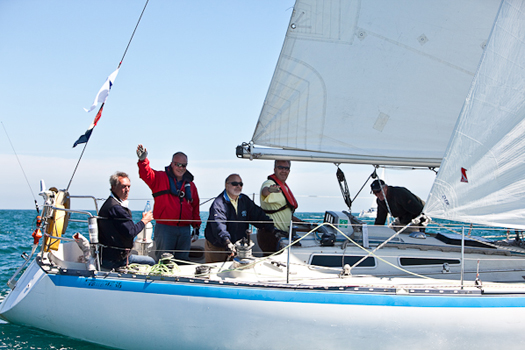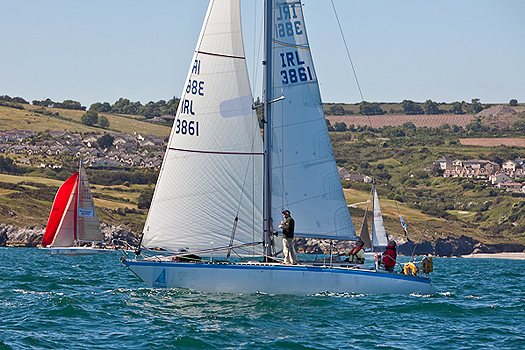Displaying items by tag: Cavatina
#roundireland14 – There were homecoming celebrations tonight for 2014 Round Ireland Race line honours winner David Ryan and his chartered Monster Projects Volvo 70 when they crossed the Wicklow finish. His clubhouse lead will, however, be shortlived, as light winds since last Saturday's start have allowed smaller, lower rated boats, currently racing down the east coast, to take a significant advantage for the overall handicap prize. We predict the overall finishing positions below.
The stretch of water that links the northern Irish Sea to the Atlantic Ocean is called the North Channel and the constriction of the water between Ireland and Scotland gives rise to some fairly significant flows, particularly around Rathlin Island. At springs, there can be in excess of 4 knots of tide on the north Antrim coast along with considerable overfalls. Consequently, were one not racing, the prudent southbound mariner would time his or her arrival at the eastern tip of Rathlin to coincide with low water Dover to not only get the benefit of six hours of south-going flood stream but also to avoid the rough water caused by the overfalls.
In this year's Round Ireland Race already there have been winners and losers. Newstalk for Adrenalin averaged 6.3 knots for this stretch, while Inis Mor, just a few hours later, averaged 7.8 knots.
At 2000 BST just 2 hours before LW Dover, Cavatina has just rounded Rathlin’s eastern tip. Although not ideal for avoiding overfalls and a couple of hour short of optimal, she is going to get about eight “free” miles from the tide, equal to one hour of elapsed time and perhaps an hour and five minutes of corrected time. It’s not only Cavatina who benefits from this tidal cycle, Leopard Clipper and Wild Spirit, immediately behind Cavatina, should get a good push as well. Up ahead, Muskox, Bow Waves Racing and McGregor IV are also in a good tidal position. However, it’s not looking so good for Big Deal, currently trying duck the adverse tide off Portrush, who look likely to suffer from being somewhat out of sync, tidally speaking.
This push will be a real boost to Cavatina who may well need it. Closest rival is now Liam Shanahan’s Ruth some 50 miles further along the track. However Ruth may well benefit from a slight but temporary veering of the wind which may change a beat to the finish to a fetch, while it currently looks like Cavatina will have it on the nose.
Afloat’s current prediction (2000hrs on Wednesday, July 2):
1. Cavatina
2. Ruth
3. IOS - Desert Star
4. Tanit
5. McGregor IV
6. Polished Manx
7. Big Deal
8. Dreamcatcher
9. Endgame
10. Muskox
Click this link for all Afloat's RoundIreland2014 coverage
It is rare enough that the west coast portion of the Round Ireland Race becomes an uphill slog but this year’s race seems set to be unusual in more ways than one. As naviticians, or should that be tactigators, are forced to abandon the rhumb line, they face numerous decisions based on relatively unpredictable factors. The light and variable winds pose particular problems – stronger inshore or offshore?, heading or lifting?, when will it shift/increase? and where should we position the boat to benefit most? In doing so, can we ignore our rivals? Is it best to stick with the pack? What will the tide effect at the headlands be?
At the very front, Monster Project’s course is more dictated by tactics then by navigation as she covers 2nd placed Teng Tools Kilcullen as they beat into Donegal Bay. It is to be hoped that this pre-occupation with each other will keep their minds off the falling winds ahead that look like making the north coast a very challenging phase.
Back down off Achill, News Talk for Adrenalin has been crossing tacks with Libertalis, not far ahead of 2012 winner Inis Mor, currently the best placed IRC boat of the high raters.
The two Class 40s, May Contain Nuts and Arwen, might as well be racing one–design, although Arwen has a modest rating advantage. Neither are currently challenging the overall lead.
Inshore just past Slyne Head, the Sydney 40 Tanit is perhaps the best placed yacht to benefit from any positive change in weather that reaches the front of the fleet first. Tanit is lying 6th overall at the time of writing.
The podium battle is just a little further back and it is the two time course and distance winner Granada 38 Cavatina that continues to maintain the lead from Sigma 33 Polished Manx and J109 Ruth.
In the two-handed class, Dehler 34 Big Deal leads from Muskox.
The two Irish Offshore School Sunfast 37s Desert Star and Sherkin are putting in a very creditable performance, currently in 7th and 8th position.
While there is significant wind coming later in the week, it will probably be too late to have any major impact, and it could well be late on Thursday before a winner can be declared.
Tips for Round Ireland Yacht Race Success by a Double Winner
Cork Harbour's Dave Hennessy is getting ready for his seventh Round Ireland race in two weeks time. The two times winner of the 704-mile offshore race in the vintage Granada 38 Cavatina gives some advice on what's involved in a successful circuit of Ireland.
Well we are off again on our seventh Round Ireland Yacht Race, this time with the very grateful sponsorship of CH Marine on board. We were asked for some ideas on tactics for the race, as we have been lucky enough to win it twice in the past.
Tactics
I think tactics play a small part in this race.The choice of boat would be the first consideration. It is a 704–mile offshore race around Ireland. The boat needs to be able to sail to her handicap over a wide range of conditions over a six day period by night and day. Cavatina is a 1979 design, weighs nine tons, has a long, sharp overhanging bow, a narrow enough stern, and like many heavy displacement boats, can keep moving in light conditions as well as coming into her own in heavy winds. In this year's fleet we seem very much the tortoise among the hares but we have been there before! The overall Fastnet winner in 2005 was a French" tortoise" beating us into second place overall by 22 minutes.
Seamanship
The next 'tactical' issue is crew. We are 12 years campaigning Cavatina offshore and have almost the same crew lining out every year. Our average age would be in late 50s but the group bring a range of skills to the boat – experience, stamina, good humour, sailing ability, mechanical, electrical skills.

The 'good humoured' crew of Cavatina go for their seventh Round Ireland race later this month. Photo: Bob Bateman
We managed to finish the '07 Fastnet where 240 of the 300 entrants were forced to retire.This is fair testimony to the crew's seamanship. I recall a bad night a few years ago approaching Inistrahull off the north coast under spinnaker with a rising gale forecast. We needed to drop the kite, gybe to avoid Scotland, but when we went to ease the halyard we found it had jumped the sheave and jammed solidly in the block at the masthead.
There was no way under the conditions to go up the mast. There was talk of shooting it with a flare even, but it was John Murphy who had the idea to ease the sheets as the boat slid down a wave, causing the kite to rise and the halyard to sit right on the sheave once again.The plan worked, kite came down for a few hours, went up again meaning we reached the fair tide at Rathlin and went on to win that race overall!
Sail Wardrobe
Another "tactical" issue to plan for is your sail wardrobe.You need to look at your boat's strengths and weaknesses in order to sail at your best in all conditions. Eric Lisson is shrewd in this regard and saw that the point of sailing from being close hauled to when you can carry a kite on a tight reach was critical for us. With Des McWilliam they came up with a Code Zero which we are only supposed to carry up to 15-knots apparent. This sail has won races for us. We also have a big overlapping furling Genoa.This means we can easily "change gear" when other crews are dragging headsails on deck or putting off marginal calls. Our main is quite small and is only reefed when it really blows.This again is a setup I feel lends itself well to offshore racing.

Cavatina passes along the Wicklow coast at the start of the 2010 Round Ireland. Photo: Bob Bateman
Victualling
Yet another issue to deal with at the planning stage is food.The crew need to be fed well to sail at their best over that time length. We pre-cook and freeze 6 main meals which are eaten in evening.We cook an FIB (full Irish breakfast) in the morning, usually served in sandwiches. Proper clothing is also essential. Thanks again CH Marine. We finished in Wicklow one year with two crew definitely hypothermic who would have been no good to us if there was another 50 miles in the race!
Lady Luck
Probably the most honest thing i can say re on the water tactics is that it is mostly luck.There are 4 tidal gates to negotiate. You sprint to Tuskar to find that gate open or closed. You slog to windward to Fastnet along the south coast, beating into the bays, risking being becalmed, or you take a chance on a long starboard tack to the south to avoid light winds.You push to reach the North Channel between Rathlin and Scotland with the gate open.This is the most critical piece of luck. We made it last year only to be completely becalmed towards Belfast Lough managing 6 miles in 10 hours! We didn't win that race! The final gate is approaching Wicklow itself. Many is the boat has come to a halt in view of the town lights, trying to sail against five knot tides in light night airs.
So if it is really down to luck why do so many do it? Yes it is a challenge heading off south past Wicklow Head into the "unknown" but for me it is the indescribable sense of achievement in "completing the circle". DO IT!
Good luck to crew of Eric Lisson, Ian Hickey, Lennie Donnery, Sean Hanley, Kelly and Dave Hennessy!





























































